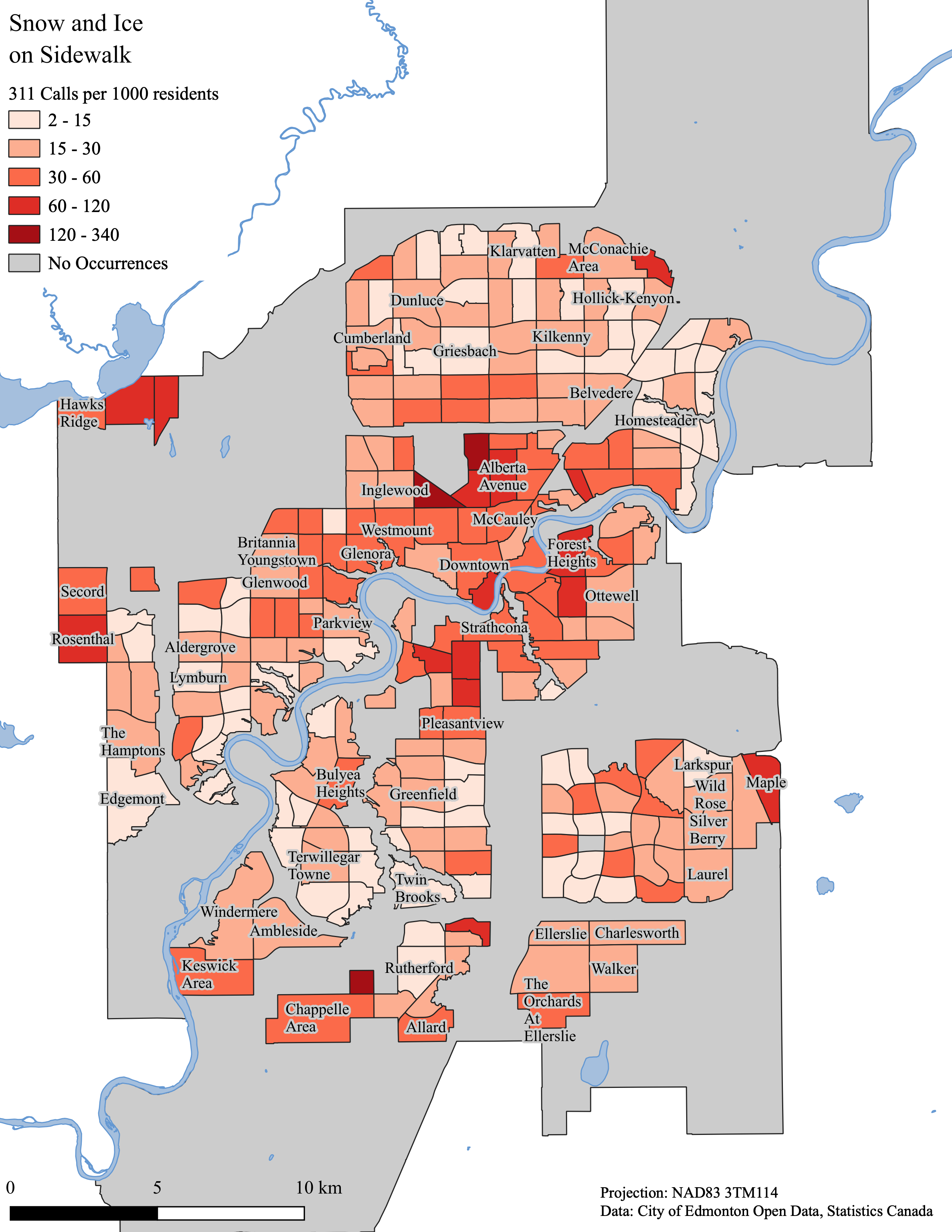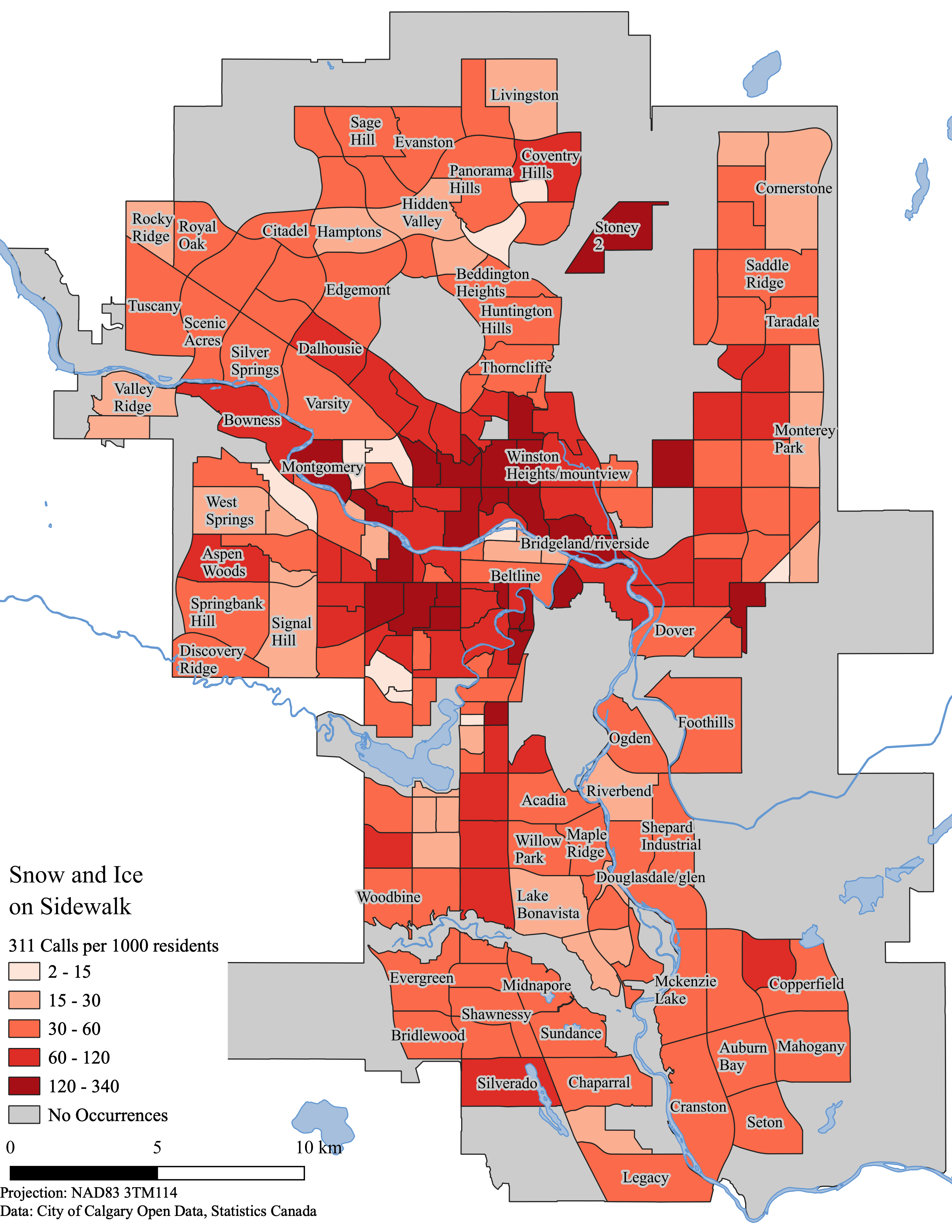Snow and Ice on Sidewalks: Complaints Made to 311 in Two Alberta Cities
Maps and article by: Darcy Reynard, former Graduate Research Assistant - GIS Analyst, Centre for Healthy Communities
January 28, 2021
The presence of snow and ice on sidewalks during the winter greatly affects the safety of their use. This is especially true for those with mobility concerns such as the elderly, individuals with vision impairments, or people who use mobility aids (e.g., wheelchairs, strollers). Snow- or ice-covered sidewalks are a public health issue for many reasons. Poorly maintained sidewalks lead to an increased risk of falls, a decline in active transportation, and an increased use of cars. The falls that occur due to poor sidewalk conditions may cause injuries, which result in more emergency department visits and hospital admissions.1 Limiting active transportation in the winter can lead to residents to being less active overall. Active living has many health benefits, such as strengthening bones and muscles, improving mood, and heart health.2 Residents may also choose car trips instead of walking or using transit. Increased car use has other public health effects like pollution.
In the Alberta cities of Calgary and Edmonton, residents are required to keep the sidewalks adjacent to their home or business free of snow and ice. Snow and ice must be cleared within 24 hours after a snowfall according to Calgary bylaws. While Edmonton’s Community Standards Bylaw simply states sidewalks must be clear of all snow and ice, without giving a specific timeframe. City-maintained sidewalks and multi-use paths in Edmonton must be cleared within 48 hours. If snow or ice is a problem on sidewalks, residents may phone 311 (a non-emergency phone number used in many cities for residents to get information, make complaints, or report problems3) to make the city aware. The two maps show the number, reported per 1000 residents, of recorded 311 calls about snow or ice on sidewalks in different communities. The data presented represents complaints made in winter 2019-2020.
The maps show that the rate of 311 calls for snow and ice on sidewalks is higher in Calgary than in Edmonton. One possible reason may be that Calgary experiences more chinooks compared to Edmonton.4 A chinook is a warm, strong, westerly wind that causes snow and ice to melt. The melt water can flow onto sidewalks and refreeze when temperatures drop. Unfortunately, Calgary does not separate snow and ice complaints in their 311 call data. Other speculative reasons could be that Calgarians walk more in the winter so encounter more snow and ice issues or that Edmontonians are more tolerant of poor sidewalk maintenance or are less aware of the 311 phone number to complain. Regardless of cause, the maps show that keeping sidewalks clear of snow and ice is a problem in these two municipalities. Snow and ice on sidewalks can be a barrier to residents’ mobility and, subsequently, have a negative impact on their health. The cities and their residents may need to improve current efforts, or find different solutions, to keep sidewalks clear and people active and enjoying the outdoors in every season.
1. https://www.toronto.ca/legdocs/mmis/2016/hl/bgrd/backgroundfile-97431.pdf
2. https://www.centre4activeliving.ca/media/filer_public/28/a4/28a4659b-1516-47e2-845d-d95bc8856213/e-benefits.pdf
3. https://www.govtech.com/dc/articles/What-is-311.html
4. https://cwf.ca/research/publications/five-facts-about-chinooks-natures-gift-to-Calgary

